A common belief, bordering on paranoia, among many Sinhala Buddhists is that some time in the foreseeable future the Sri Lankan Muslims, driven by unfettered population growth, will emerge as the Majority Community in this Island Nation, thereby reducing the Sinhala Buddhists to a minority in what they often describe very emotionally as the only Country in the World that they can call their own”. The following popular perceptions of Muslims are very often mentioned as evidence of this inevitable catastrophe.
- SL Muslims have the highest population growth rates
- SL Muslims have large families
- SL Muslims do not practice family planning
- The percentage of SL Muslims in the total population is steadily increasing
- SL Muslims are wealthy
- Muslim Males can have four wives simultaneously
- Muslims have high fertility rates
- Islam is the fastest growing religion in the World
Although many Muslims have attempted to address this issue and allay such fears, it continues to persist and is made use of by various racist elements and groups to foment and aggravate anti-Muslim sentiments to achieve their own political, economic and social goals.
This article is yet another attempt to lay to rest once and for all this irrational, atavistic fear among the Sinhala Buddhists. It will examine the impact of the Muslim Population in two distinct stages – the past and the future – and will demonstrate beyond any and all doubt that there is absolutely no valid basis for any such fear on the part of the Buddhist Community.
The Past Scenario:
According to the data published by the Department of Census & Statistics, the Buddhist and Muslim Populations at each of the 13 Censuses conducted periodically since 1881 are as follows:
The size of the gap between the numbers of Buddhists and Muslims in Sri Lanka has continued to increase steadily since 1881. This is illustrated more clearly in the chart below.
If the Gap between the two populations is steadily increasing, then one does not need to possess an intelligence of Einsteinian proportions to conclude that the number of Muslims is not poised to exceed the number of Buddhists in the foreseeable future in Sri Lanka.
Therefore, based on official Government Population Statistics for the past 130 years, there is absolutely no reason whatsoever for the Buddhist Community to harbor even an iota of concern, apprehension or fear that they will be reduced to a minority by the Muslims in Sri Lanka.
The Future Scenario : The focus then shifts to the future – specifically the population estimates based on past trends. These estimates are of two types – ‘share-based’ and ‘growth-based’.
Share-based Forecasts: This refers to the oft-quoted ‘share’ of the Total Population accounted for by the Muslim Community in Sri Lanka. The relevant share for each Census Year is given in the chart below.
Therefore, based on official Government Population Statistics for the past 130 years, there is absolutely no reason whatsoever for the Buddhist Community to harbor even an iota of concern, apprehension or fear that they will be reduced to a minority by the Muslims in Sri Lanka.
The Future Scenario : The focus then shifts to the future – specifically the population estimates based on past trends. These estimates are of two types – ‘share-based’ and ‘growth-based’.
Share-based Forecasts: This refers to the oft-quoted ‘share’ of the Total Population accounted for by the Muslim Community in Sri Lanka. The relevant share for each Census Year is given in the chart below.
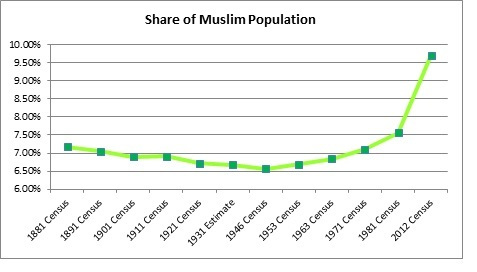
It is fairly common nowadays to find ‘analyses’ being performed on the population shares of the major ethnic groups in Sri Lanka over the past 100 years to justify and reinforce the fears of the Buddhist Community that sometime in the very distant future, they will swamped by the Muslims of Sri Lanka. A noteworthy feature of all these forecasts is that the unit of analysis is the seemingly harmless ‘percentage’.
In their rush to identify the date of this catastrophic event, these ‘Analysts’ appear to have forgotten the fact that a ‘Percentage’ is merely a number or ratio expressed as a fraction of 100 and is calculated on some specific base. For example, the base could be the Population of Sri Lanka in 2011 and the proportions accounted for by the Buddhist and Muslim Communities are 70.2% and 9.7% respectively. Moreover, ‘Percentages’ are used essentially to compare the status of a single variable in two or more different bases or of multiple variables in a single base. For example, Muslims accounted for 7% of the total population in 1981 and 9.7% of the total population in 2011.
Being numerically a type of index, percentages cannot be subjected to any mathematical operation (i.e. addition, subtraction, multiplication or division) unless – and only if – such percentages refer to calculations performed on the same base. It is therefore mathematically incorrect to calculate a forecast based on trend data consisting of percentages relating to different time periods for the simple reason that whatever be the model used for estimation (i.e. Linear, Exponential, Polynomial, Moving Averages or whatever), the method will involve the use of a combination of mathematical operations.
Therefore, future population estimates cannot be based on historical ‘shares’ (or percentages) data.
Growth-based Forecasts : This refers to the use of ‘Rates of Growth’ of the different Population Groups between any two Census Years. Proponents of this method of analysis focus on the Population data for the 1981 and 2011/2012 Census. This is given in the table below.
In their rush to identify the date of this catastrophic event, these ‘Analysts’ appear to have forgotten the fact that a ‘Percentage’ is merely a number or ratio expressed as a fraction of 100 and is calculated on some specific base. For example, the base could be the Population of Sri Lanka in 2011 and the proportions accounted for by the Buddhist and Muslim Communities are 70.2% and 9.7% respectively. Moreover, ‘Percentages’ are used essentially to compare the status of a single variable in two or more different bases or of multiple variables in a single base. For example, Muslims accounted for 7% of the total population in 1981 and 9.7% of the total population in 2011.
Being numerically a type of index, percentages cannot be subjected to any mathematical operation (i.e. addition, subtraction, multiplication or division) unless – and only if – such percentages refer to calculations performed on the same base. It is therefore mathematically incorrect to calculate a forecast based on trend data consisting of percentages relating to different time periods for the simple reason that whatever be the model used for estimation (i.e. Linear, Exponential, Polynomial, Moving Averages or whatever), the method will involve the use of a combination of mathematical operations.
Therefore, future population estimates cannot be based on historical ‘shares’ (or percentages) data.
Growth-based Forecasts : This refers to the use of ‘Rates of Growth’ of the different Population Groups between any two Census Years. Proponents of this method of analysis focus on the Population data for the 1981 and 2011/2012 Census. This is given in the table below.

First, a word about trend lines or trend curves based on growth rates. The simple fact of the matter is that any two trend lines or curves must intersect at some point unless the lines are perfectly parallel as illustrated in the three charts below.

If the growth rate of the ‘Upper’ Trend Line is greater than that of the ‘Lower’ Trend Line, then the two lines would have intersected sometime in the past. (Chart 1)
If the growth rate of the ‘Upper’ Trend Line is less than that of the ‘‘Lower’ Trend Line, then the two lines would intersected sometime in the future. (Chart 2)
If the growth rates of the ‘‘Upper’ Trend Line and that of the ‘Lower’ Trend Line are equal, then the two lines would never intersect. (Chart 3)
In the cases of the trend lines or curves for the Buddhist and Muslim Population data, the growth rate of the ‘Upper Buddhist Line’ (1.1%) is less than that of the ‘Lower Muslim Line’ (1.9%). Therefore the two lines must intersect sometime in the future. And at that point in time, the Muslim Population would be equal to the Buddhist Population.
In order to determine the point in time when the two populations are equal, the two populations are extrapolated exponentially using the 2012 data as the base and the applying the corresponding growth rates annually. The detailed estimates at the end of every decade are given in the table below.
[The formula used to calculate the annual estimate is as follows :
Estimated Population for a specific year = Estimated Population for previous year x (1+r), where r is the rate of growth expressed in decimals.]
If the growth rate of the ‘Upper’ Trend Line is less than that of the ‘‘Lower’ Trend Line, then the two lines would intersected sometime in the future. (Chart 2)
If the growth rates of the ‘‘Upper’ Trend Line and that of the ‘Lower’ Trend Line are equal, then the two lines would never intersect. (Chart 3)
In the cases of the trend lines or curves for the Buddhist and Muslim Population data, the growth rate of the ‘Upper Buddhist Line’ (1.1%) is less than that of the ‘Lower Muslim Line’ (1.9%). Therefore the two lines must intersect sometime in the future. And at that point in time, the Muslim Population would be equal to the Buddhist Population.
In order to determine the point in time when the two populations are equal, the two populations are extrapolated exponentially using the 2012 data as the base and the applying the corresponding growth rates annually. The detailed estimates at the end of every decade are given in the table below.
[The formula used to calculate the annual estimate is as follows :
Estimated Population for a specific year = Estimated Population for previous year x (1+r), where r is the rate of growth expressed in decimals.]
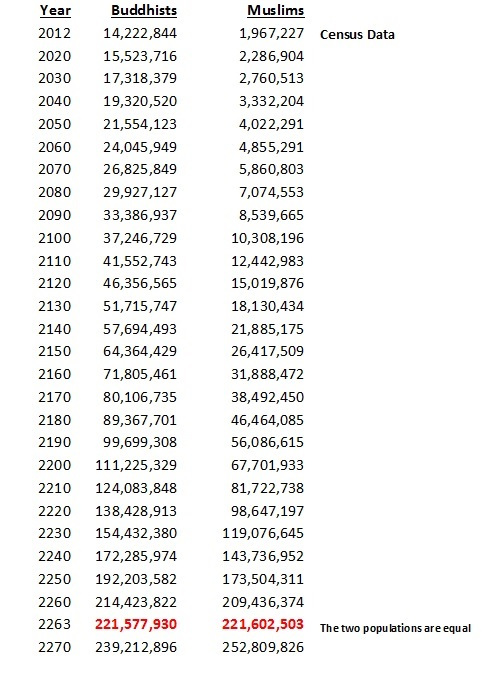

Therefore it appears to be the case that, 251 years hence, in the Year 2263, the worst fears of the Buddhist Community will be realized with the Muslim Population emerging as the Majority Community in Sri Lanka ! An underlying assumption, as in the cases of all such extrapolations , is that the political, economic, social and technological factors that existed during the 30-year period 1981 – 2011 , will continue to exist during the next 250 years too. Is this a realistic, sensible assumption?
To test the credibility of this ‘Growth-based Forecasts’, similar extrapolations of population size are also developed for two other religious groups – Roman Catholics and Non-RC Christians. The relevant basic data are as follows:
To test the credibility of this ‘Growth-based Forecasts’, similar extrapolations of population size are also developed for two other religious groups – Roman Catholics and Non-RC Christians. The relevant basic data are as follows:

The annual estimates of population size are given below for all four religious groups.
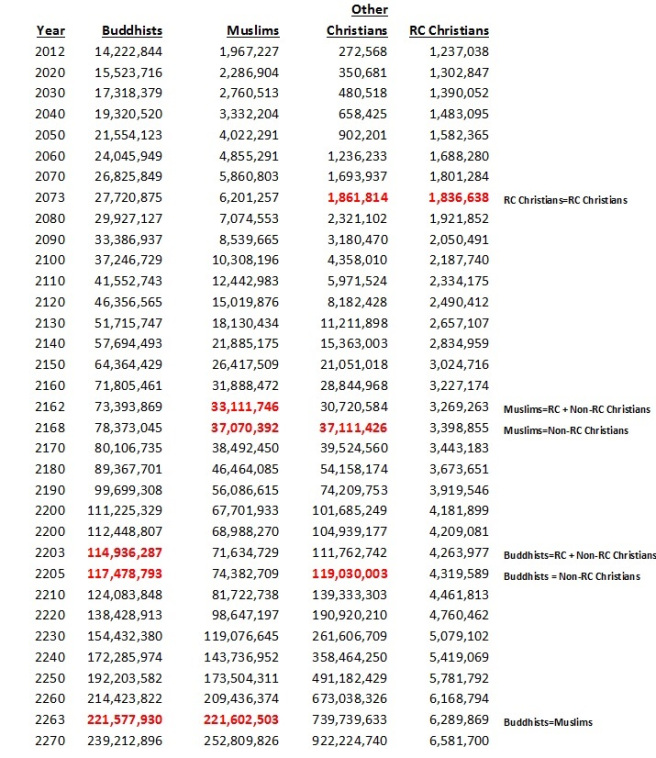
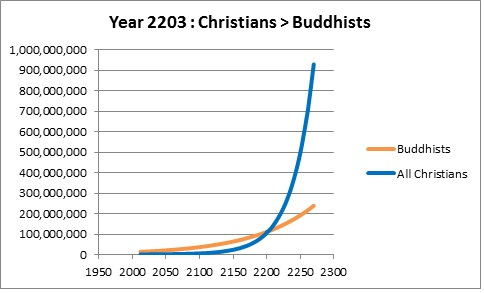

So in a nutshell, what the above extrapolation exercise, based on Census data for 1981 and 2012 tells us is that:
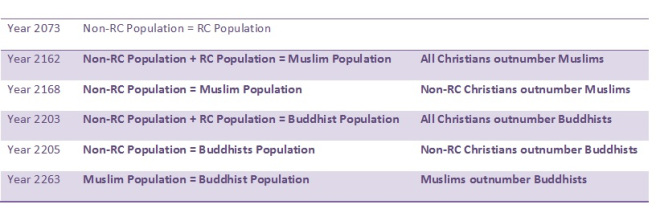
Thus, if the exponential growth Method of Extrapolation is deemed to be acceptable and accurate, then it appears to be the case that in the Year 2203, Sri Lanka will become a Majority Christian Nation pushing the Buddhists to second place in terms of population. Then a further 60 years later, in 2263, the Buddhists will be pushed to third position by the Muslim Community.
And the icing on the cake is that at this point in time (Year 2262), the Total Population of Sri Lanka will be in excess of 1.1 Billion !!! (which is the current population of India). Looks like Sri Lanka is heading for a pretty crowded future.
The very nature of such estimates reflects very strongly the crassness, stupidity and ridiculousness of estimating population sizes beyond reasonable limits of time. The purpose of introducing the two Christian Groups into the calculations was not to create problems for that Community, but merely to highlight the absurdity of using this method of estimation.
Conclusion: Based on this analysis of the Past and Future Scenarios, it is therefore concluded that the Muslim Community in no way poses a credible threat to the Majority Community of Sri Lanka with regard to population growth.
And the icing on the cake is that at this point in time (Year 2262), the Total Population of Sri Lanka will be in excess of 1.1 Billion !!! (which is the current population of India). Looks like Sri Lanka is heading for a pretty crowded future.
The very nature of such estimates reflects very strongly the crassness, stupidity and ridiculousness of estimating population sizes beyond reasonable limits of time. The purpose of introducing the two Christian Groups into the calculations was not to create problems for that Community, but merely to highlight the absurdity of using this method of estimation.
Conclusion: Based on this analysis of the Past and Future Scenarios, it is therefore concluded that the Muslim Community in no way poses a credible threat to the Majority Community of Sri Lanka with regard to population growth.
Courtesy: Bisthanbatcha

Leave your comments
Login to post a comment
Post comment as a guest